A New NVM Device Driver for IoT Time Series Database
Abstract
:1. Introduction
- Given the large concurrent write operations in IoT time series databases, several queues are used in NVM device drivers to manage I/O requests, respectively. A new I/O request structure named Tio was designed to contain the characteristics of the IoT time series data, and multiple threads were used to manage the Tio in parallel. This can effectively improve the concurrency of the NVM device driver and take advantage of the read and write speed of the NVM device.
- According to the different acquisition frequencies of IoT devices, a lightweight load balance mechanism based on frequency was designed. This can improve the efficiency of I/O management in NVM device drivers and increase the throughput rate and reduce the latency of IoT time series databases.
- A prototype of new NVM device driver for IoT time series databases named TS-PMEM was implemented. Two popular time series databases and one IoT time series database based on NVM devices from our group [8] were used for testing by using a general test tool for time series databases named YCSB-TS, and compared with the popular NVM device driver named PMEM from Intel. The results showed that TS-PMEM can increase the write throughput of time series databases by 18.6%, improve the query throughput by 10.6%, reduce the write latency by 8.3%, and decrease the query latency by 6.4% in the maximum compared with the current NVM device driver.
2. Related Works
2.1. NVM Simulator and Driver
2.2. NVM Database
2.3. Time Series Database
3. NVM Device Driver Structure for IoT Time Series Databases
4. Multi-Queue Management Strategy
5. Lightweight Load Balance Mechanism Based on Frequency
6. Prototype and Evaluation
6.1. Prototype and Test Environment
6.2. Write Throughput
6.3. Write Latency
6.4. Query Throughput
6.5. Query Latency
7. Conclusions and Future Works
Author Contributions
Funding
Conflicts of Interest
References
- Rinaldi, S.; Bonafini, F.; Ferrari, P.; Flammini, A.; Sisinni, E.; Bianchini, D. Impact of Data Model on Performance of Time Series Database for Internet of Things Applications. In Proceedings of the 2019 IEEE International Instrumentation and Measurement Technology Conference (I2MTC), Auckland, New Zealand, 20–23 May 2019. [Google Scholar]
- Rhea, S.; Wang, E.; Wong, E.; Atkins, E.; Storer, N. LittleTable: A Time-Series Database and Its Uses. In Proceedings of the 2017 ACM International Conference on Management of Data, Chicago, IL, USA, 14–19 May 2017. [Google Scholar]
- Jing, L.; Lam, C. Phase change memory. Sci. China Inf. Sci. 2011, 54, 1061–1072. [Google Scholar]
- Kuan, K.; Adegbija, T. Mirrorcache: An Energy-Efficient Relaxed Retention L1 STTRAM Cache. In Proceedings of the 2019 on Great Lakes Symposium on VLSI, Tysons Corner, VA, USA, 9–11 May 2019. [Google Scholar]
- Dadmal, U.D.; Vinkare, R.S.; Kaushik, P.G.; Mishra, S.A. 3D-XPoint Technology. Int. J. Electron. Commun. Soft Comput. Sci. Eng. 2017, 13–17. Available online: https://ijecscse.org/papers/IETE2017/3.pdf (accessed on 25 January 2022).
- Intel: Intel Optane DC Persistent Memory. 2019. Available online: https://www.intel.com/content/www/us/en/architecture-and-technology/optane-dc-persistent-memory.html (accessed on 25 January 2022).
- Swanson, S.; Caulfield, A.M. Refactor, reduce, recycle: Restructuring the I/O stack for the future of storage. Computer 2013, 46, 52–59. [Google Scholar] [CrossRef]
- Cai, T.; Liu, P.; Niu, D.; Shi, J.; Li, L. The Embedded IoT Time Series Database for Hybrid Solid-State Storage System. Sci. Program. 2021, 2021, 9948533. [Google Scholar] [CrossRef]
- Yoo, J.; Won, Y.; Hwang, J.; Kang, S.; Choi, J.; Yoon, S.; Cha, J. VSSIM: Virtual Machine Based SSD Simulator. In Proceedings of the 2013 IEEE 29th Symposium on Mass Storage Systems and Technologies (MSST), Long Beach, CA, USA, 6–10 May 2013. [Google Scholar]
- Tavakkol, A.; Gómez-Luna, J.; Sadrosadati, M.; Ghose, S.; Mutlu, O. MQSim: A Framework for Enabling Realistic Studies of Modern Multi-Queue SSD Devices. In Proceedings of the 16th Conference on File and Storage Technologies, Oakland, CA, USA, 12–15 February 2018; USENIX Association: Berkeley, CA, USA, 2018; pp. 49–66. [Google Scholar]
- Jung, M.; Zhang, J.; Abulila, A.; Kwon, M.; Shahidi, N.; Shalf, J.; Kim, N.S.; Kandemir, M. Simplessd: Modeling solid state drives for holistic system simulation. J. IEEE Comput. Archit. Lett. 2017, 17, 37–41. [Google Scholar] [CrossRef] [Green Version]
- Gouk, D.; Kwon, M.; Jie, Z.; Koh, S.; Choi, W.; Kim, N.S.; Kandemir, M.; Jung, M. Amber*: Enabling Precise Full-System Simulation with Detailed Modeling of all SSD Resources. In Proceedings of the 2018 51st Annual IEEE/ACM International Symposium on Microarchitecture (MICRO), Fukuoka, Japan, 20–24 October 2018. [Google Scholar]
- Lee, J.; Byun, E.; Park, H.; Choi, J.; Lee, D.; Noh, S.H. Cps-Sim: Configurable and Accurate Clock Precision Solid State Drive Simulator. In Proceedings of the 2009 ACM Symposium on Applied Computing, Honolulu, Hawaii, 8–12 March 2009; pp. 318–325. [Google Scholar]
- Caulfield, A.M.; De, A.; Coburn, J.; Mollow, T.I.; Gupta, R.K.; Swanson, S. Moneta: A high-performance storage array architecture for next-generation, non-volatile Memories. MICRO 2010, 33, 385–395. [Google Scholar]
- Volos, H.; Magalhaes, G.; Cherkasova, L.; Li, J. Quartz: A Lightweight Performance Emulator for Persistent Memory Software. In Proceedings of the 16th Annual Middleware Conference, Vancouver, BC, Canada, 7–11 December 2015; pp. 37–49. [Google Scholar]
- Jung, M. OpenExpress: Fully Hardware Automated Open Research Framework for Future Fast NVMe Devices. In Proceedings of the 18th Conference on File and Storage Technologies, Santa Clara, CA, USA, 24–27 February 2020; USENIX Association: Berkeley, CA, USA, 2020; pp. 649–656. [Google Scholar]
- Poremba, M.; Xie, Y. NVMain: An Architectural-Level Main Memory Simulator for Emerging Non-Volatile Memories. In Proceedings of the 2012 IEEE Computer Society Annual Symposium on VLSI, Amherst, MA, USA, 19–21 August 2012; pp. 392–397. [Google Scholar]
- Poremba, M.; Zhang, T.; Xie, Y. NVMain 2.0: A user-friendly memory simulator to model non-volatile memory systems. J. IEEE 2015, 14, 140–143. [Google Scholar] [CrossRef]
- Wang, D.; Ganesh, B.; Tuaycharoen, N.; Baynes, K.; Jaleel, A.; Jacob, B. DRAMsim: A Memory System Simulator. J. ACM 2005, 33, 100–107. [Google Scholar] [CrossRef]
- Rosenfeld, P.; Cooperbalis, E.; Jacob, B. DRAMSim2: A cycle accurate memory system simulator. J. IEEE 2011, 10, 16–19. [Google Scholar] [CrossRef]
- Sanchez, D.; Kozyrakis, C. ZSim: Fast and Accurate Microarchitectural Simulation of Thousand-Core Systems. ACM 2013, 41, 475–486. [Google Scholar]
- Le, Q.; Upadhyayula, U. How to Emulate Persistent Memory Using Dynamic Random-access Memory. 2016. Available online: https://software.intel.com/content/www/us/en/develop/articles/how-to-emulate-persistent-memory-on-an-intel-architecture-server.html (accessed on 25 January 2022).
- Xia, F.; Jiang, D.; Xiong, J.; Sun, N. HiKV: A Hybrid Index Key-Value Store for DRAM-NVM Memory Systems. In Proceedings of the 2017 USENIX Annual Technical Conference (USENIX ATC 17), Santa Clara, CA, USA, 12–14 July 2017. [Google Scholar]
- Arulraj, J.; Levandoski, J.; Minhas, U.F.; Larson, P.A. BzTree: A high-performance latch-free range index for non-volatile memory. Proc. VLDB Endow. 2018, 11, 553–565. [Google Scholar] [CrossRef]
- Kaiyrakhmet, O.; Lee, S.; Nam, B.; Noh, S.H.; Choi, Y.R. SLM-DB: Single-Level Key-Value Store with Persistent Memory. In Proceedings of the 17th USENIX Conference on File and Storage Technologies (FAST 19), Boston, MA, USA, 25–28 February 2019. [Google Scholar]
- Lin, Z.; Kai, L.; Cheng, Z.; Wan, J. RangeKV: An Efficient Key-Value Store Based on Hybrid DRAM-NVM-SSD Storage Structure. IEEE Access 2020, 8, 154518–154529. [Google Scholar]
- Li, W.; Jiang, D.; Xiong, J.; Bao, Y. HiLSM: An LSM-Based Key-Value Store for Hybrid NVM-SSD Storage Systems. In Proceedings of the 17th ACM International Conference on Computing Frontiers, Sicily, Italy, 11–13 May 2020. [Google Scholar]
- Yao, T.; Zhang, Y.; Wan, J.; Cui, Q.; Tang, L.; Jiang, H.; Xie, C.; He, X. MatrixKV: Reducing Write Stalls and Write Amplification in LSM-Tree Based KV Stores with Matrix Container in NVM. In Proceedings of the 2020 USENIX Annual Technical Conference (USENIX ATC 20), Online. 15–17 July 2020. [Google Scholar]
- Zhong, W.; Chen, C.; Wu, X.; Jiang, S. REMIX: Efficient Range Query for LSM-Trees. In Proceedings of the 19th USENIX Conference on File and Storage Technologies (FAST 21), Online. 23–25 February 2021. [Google Scholar]
- Jensen, S.K.; Pedersen, T.B.; Thomsen, C. Time series management systems: A survey. IEEE Trans. Knowl. Data Eng. 2017, 29, 2581–2600. [Google Scholar] [CrossRef] [Green Version]
- O’Neil, P.; Cheng, E.; Gawlick, D.; O’Neil, E. The log-structured merge-tree (LSM-tree). Acta Inf. 1996, 33, 351–385. [Google Scholar] [CrossRef]
- KairosDB: Fast Time Series Database on Cassandra. 2017. Available online: http://kairosdb.github.io/ (accessed on 16 February 2022).
- OpenTSDB: The Scalable Time Series Database. Available online: http://opentsdb.net/ (accessed on 16 February 2022).
- Influxdb.com: InfluxDB—Open Source Time Series, Metrics, and Analytics Database. 2015. Available online: https://www.influxdata.com/ (accessed on 16 February 2022).
- Yagoubi, D.E.; Akbarinia, R.; Masseglia, F.; Palpanas, T. Massively Distributed Time Series Indexing and Querying. IEEE Trans. Knowl. Data Eng. 2018, 32, 108–120. [Google Scholar] [CrossRef] [Green Version]
- Pelkonen, T.; Franklin, S.; Teller, J.; Cavallaro, P.; Huang, Q.; Meza, J.; Veeraraghavan, K. Gorilla: A Fast, Scalable, in-Memory Time Series Database. Proc. VLDB Endow. 2015, 8, 1816–1827. [Google Scholar] [CrossRef]
- Jensen, S.K.; Pedersen, T.B.; Thomsen, C. ModelarDB: Modular Model-Based Time Series Management with Spark and Cassandra. Proc. VLDB Endow. 11, 1688–1701. [CrossRef]
- Visheratin, A.; Struckov, A.; Yufa, S.; Muratov, A.; Nasonov, D.; Butakov, N. Peregreen–Modular Database for Efficient Storage of Historical Time Series in Cloud Environments. In Proceedings of the 2020 USENIX Annual Technical Conference (USENIX ATC 20), Philadelphia, PA, USA, 15–17 July 2020. [Google Scholar]
- Love, R. The Bio Structure. 2005. Available online: http://books.gigatux.nl/mirror/kerneldevelopment/0672327201/ch13lev1sec3.html (accessed on 26 February 2022).
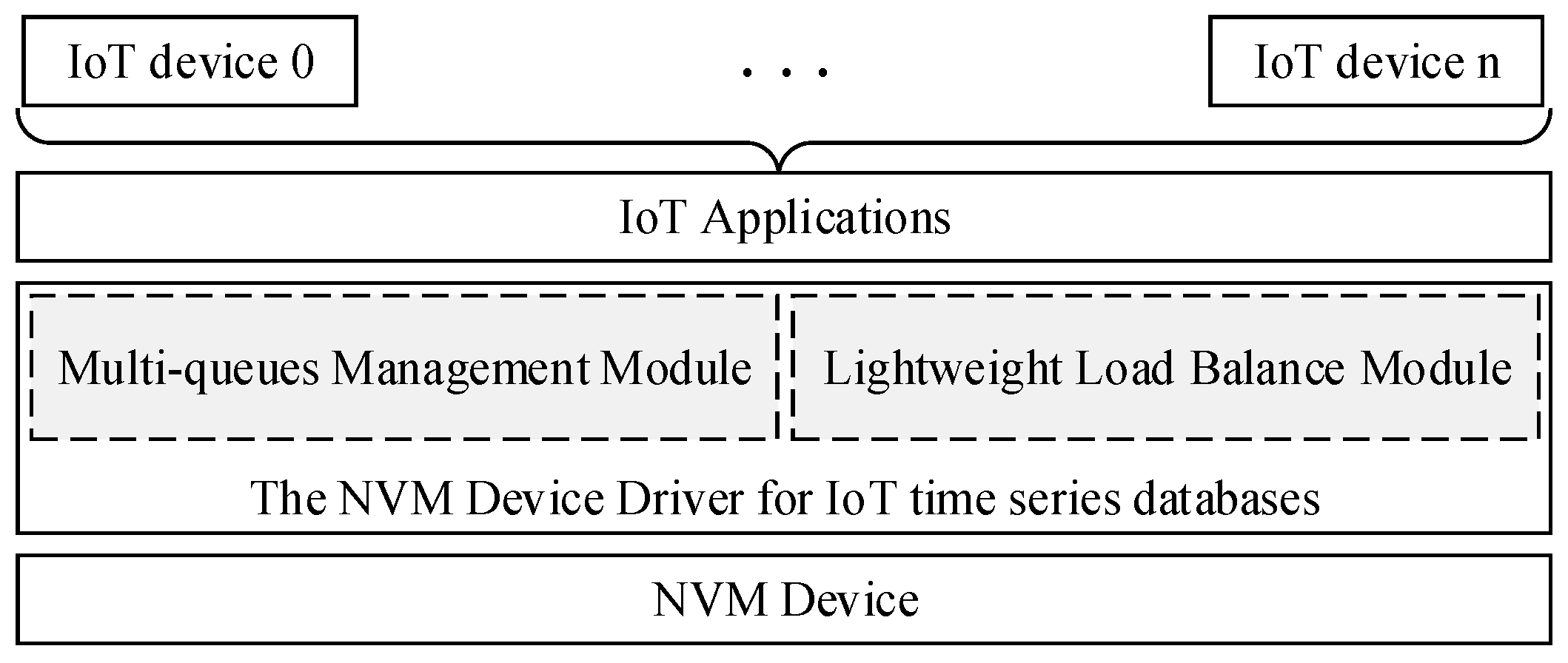

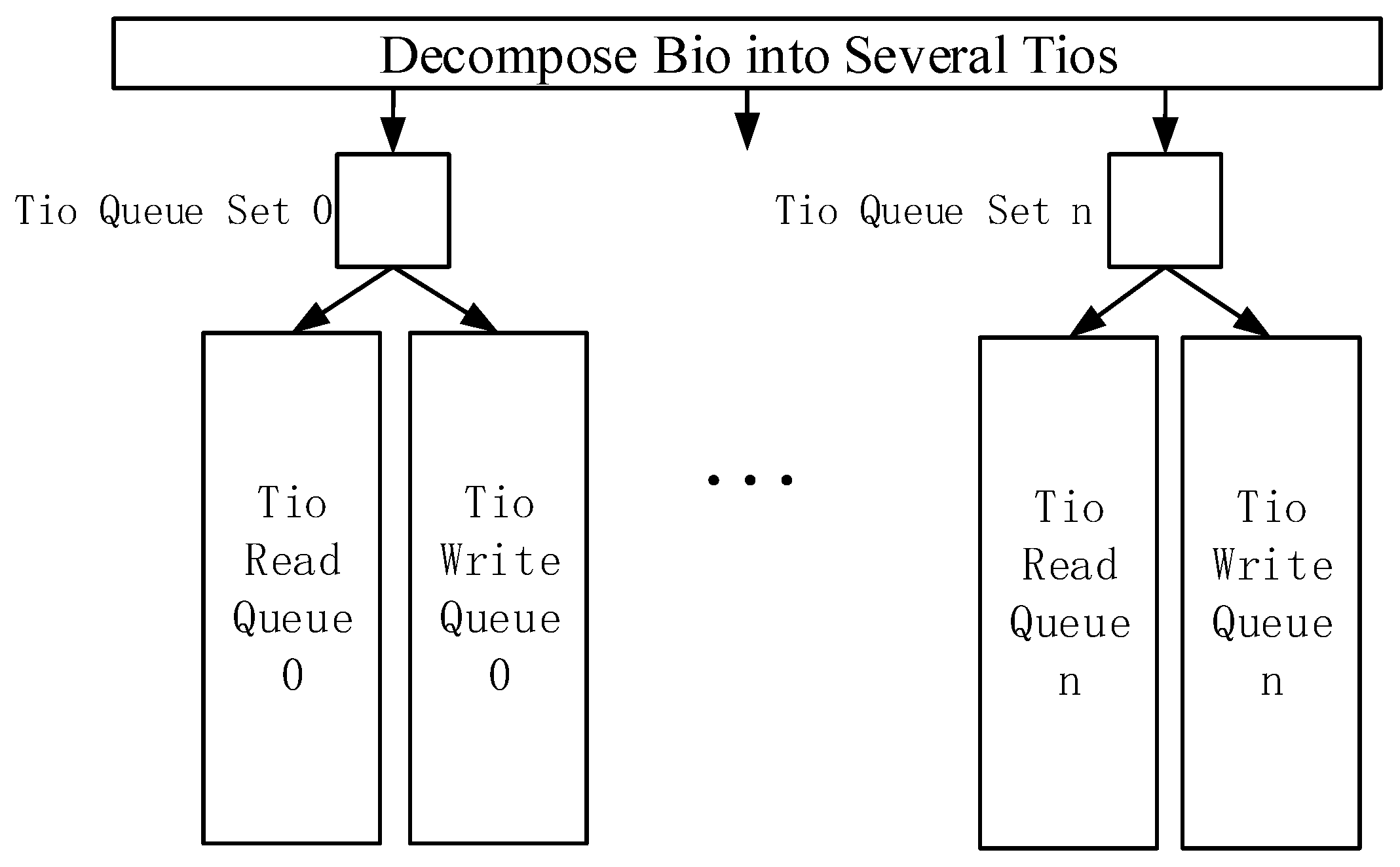


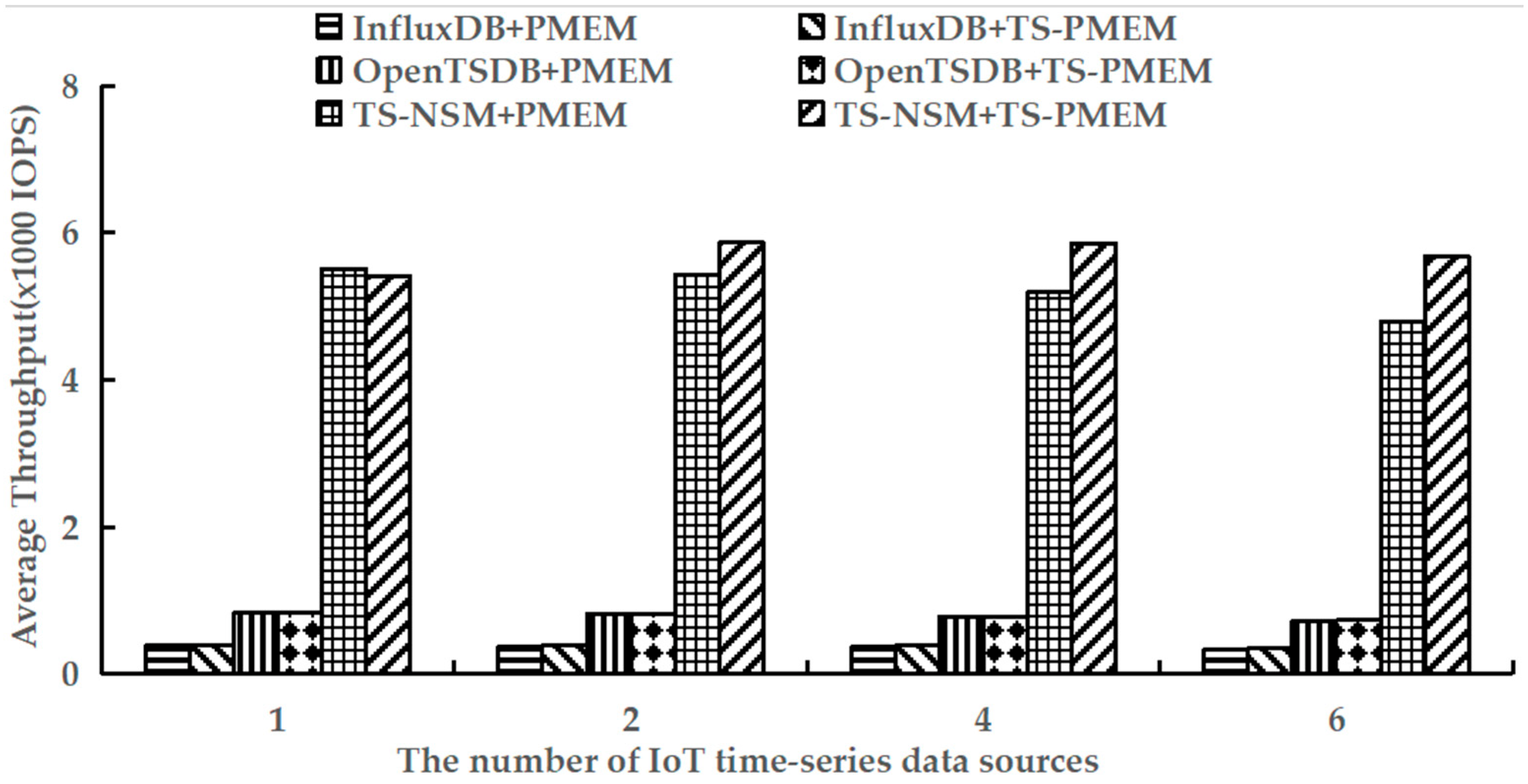
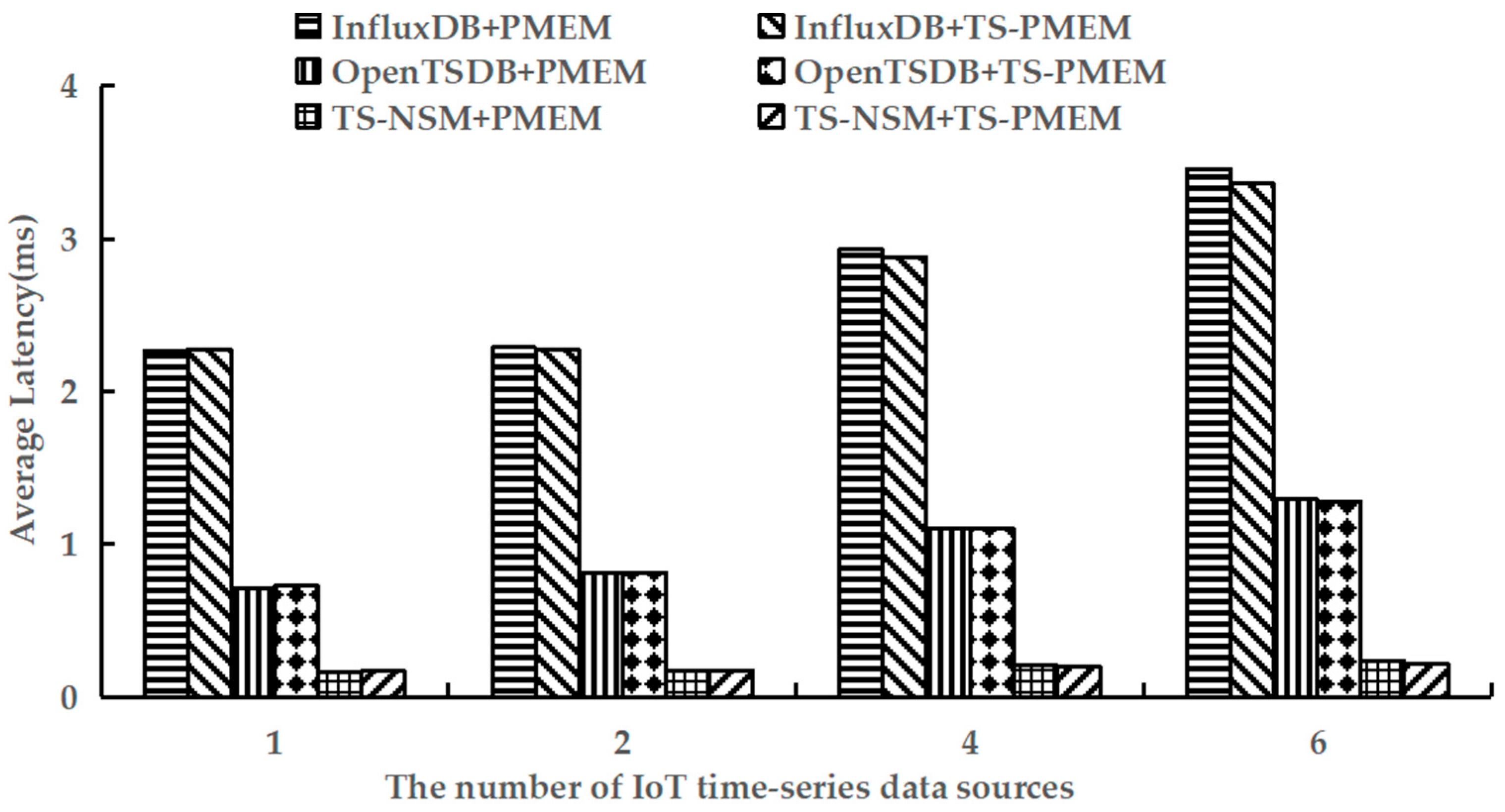
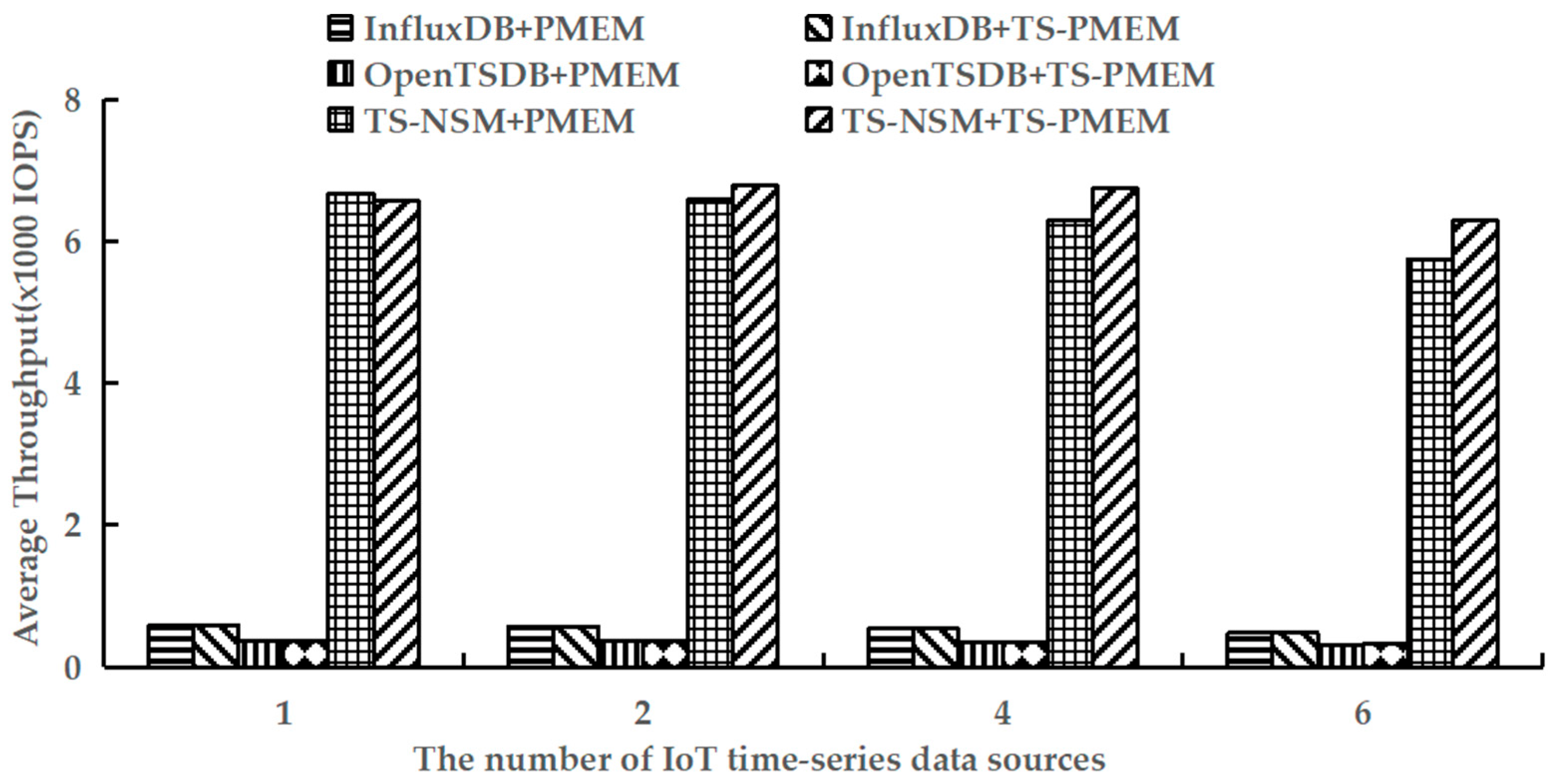
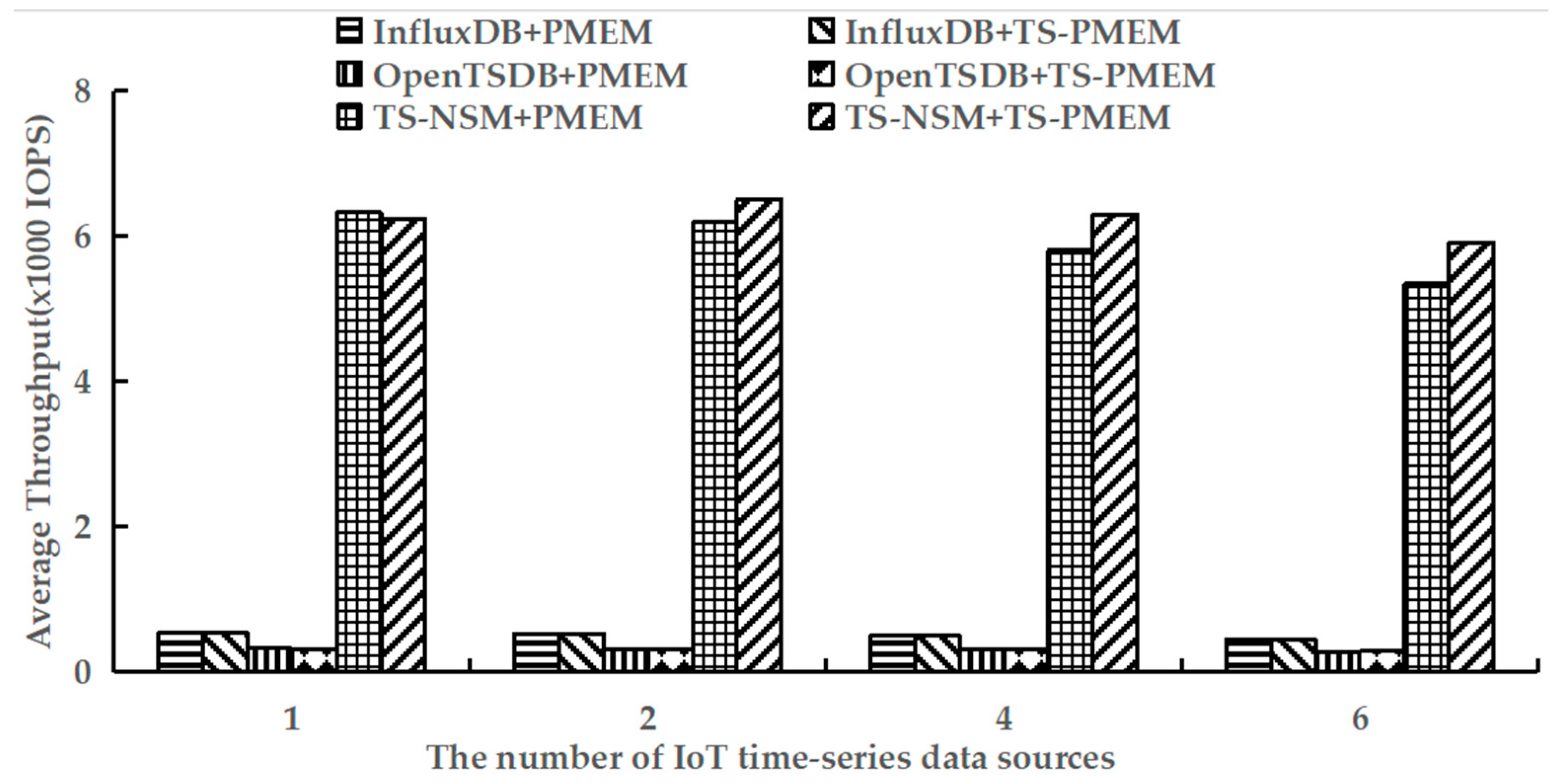
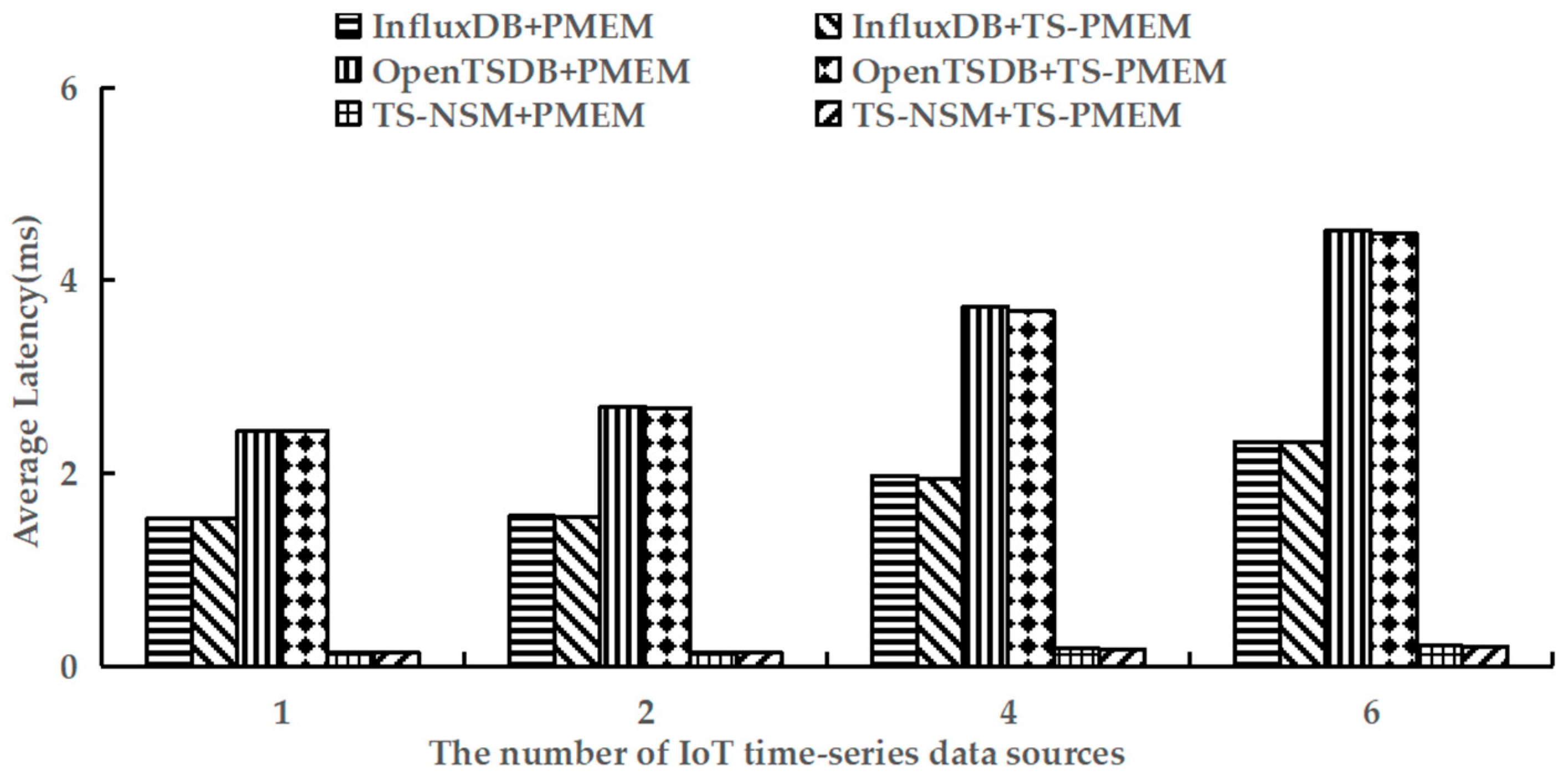
| Components | Configuration |
|---|---|
| CPU | Intel Xeon Platinum 8260 M 2.30 G |
| Memory | 128 GB |
| NVM device | 2 × 128 GB Intel Optane DC Persistent Memory |
| Disk | 256 GB NVMe SSD |
| OS | CentOS 7.0, Kernel 4.4.112 |
Publisher’s Note: MDPI stays neutral with regard to jurisdictional claims in published maps and institutional affiliations. |
© 2022 by the authors. Licensee MDPI, Basel, Switzerland. This article is an open access article distributed under the terms and conditions of the Creative Commons Attribution (CC BY) license (https://creativecommons.org/licenses/by/4.0/).
Share and Cite
Cai, T.; Ma, Y.; Liu, P.; Niu, D.; Li, L. A New NVM Device Driver for IoT Time Series Database. Micromachines 2022, 13, 385. https://doi.org/10.3390/mi13030385
Cai T, Ma Y, Liu P, Niu D, Li L. A New NVM Device Driver for IoT Time Series Database. Micromachines. 2022; 13(3):385. https://doi.org/10.3390/mi13030385
Chicago/Turabian StyleCai, Tao, Yueming Ma, Peiyao Liu, Dejiao Niu, and Lei Li. 2022. "A New NVM Device Driver for IoT Time Series Database" Micromachines 13, no. 3: 385. https://doi.org/10.3390/mi13030385
APA StyleCai, T., Ma, Y., Liu, P., Niu, D., & Li, L. (2022). A New NVM Device Driver for IoT Time Series Database. Micromachines, 13(3), 385. https://doi.org/10.3390/mi13030385






